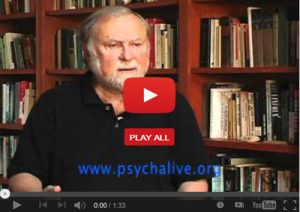Factors that Increase or Suppress Death Anxiety
 Death anxiety encompasses a broad spectrum of emotions ranging from a few passing moments of fear to a complete state of panic. In either case, the experience is painful on a feeling level or, at its worst, terrifying. For this reason, most people find a way to obliterate images of death’s finality from their conscious minds. Despite their awareness to the contrary, in their magical thinking, free from logical constraints, they are somehow able to sustain a fantasy or illusion of immortality. In previous blogs, I have described specific behaviors, attitudes, and belief systems that deny death and attempt to suppress death fears. Nevertheless, there are certain incidents and circumstances throughout the lifespan that tend to arouse death anxiety.
Death anxiety encompasses a broad spectrum of emotions ranging from a few passing moments of fear to a complete state of panic. In either case, the experience is painful on a feeling level or, at its worst, terrifying. For this reason, most people find a way to obliterate images of death’s finality from their conscious minds. Despite their awareness to the contrary, in their magical thinking, free from logical constraints, they are somehow able to sustain a fantasy or illusion of immortality. In previous blogs, I have described specific behaviors, attitudes, and belief systems that deny death and attempt to suppress death fears. Nevertheless, there are certain incidents and circumstances throughout the lifespan that tend to arouse death anxiety.
Some people totally deny any fear of death, while others, who are better able to contemplate it with equanimity, use the awareness of death to give greater meaning to their lives. However, the majority utilizes a variety of psychological defense mechanisms in an attempt to avoid awakening repressed feelings of fear and dread.
The problem is that the same defenses that help calm death anxiety also have negative consequences that limit a person’s life experience. For example, for many the belief in an eternal life or soul that survives has led to a corresponding shame about the body, i.e. nudity and sexuality. The latter activities are seen as dirty or sinful earthly pleasures, which cause much pain, guilt, and emotional problems.
The denial of death has caused individuals to fail to take their lives seriously and to not approach life with respect for themselves and others. Many are inclined to squander their existence, believing that they have unlimited time. Others pledge mindless allegiance to causes, leaders, or other individuals who serve as “ultimate rescuers;” while sacrificing their own strength and independence. Moreover, people are threatened by those who hold different belief systems. Conflict over different religious orientations has led to prejudice, ethnic cleansing, and actual warfare.
Circumstances and Events that Trigger Death Anxiety
Paradoxically, both positive and negative circumstances and events tend to arouse or intensify latent or suppressed feelings of death anxiety.
Positive circumstances that trigger death anxiety. In my clinical practice, I have observed innumerable examples of clients experiencing heightened death anxiety following uniquely positive experiences. Experiences such as an important achievement or recognition, falling in love and making a commitment in a relationship, having an especially meaningful dialogue with a friend or a sensitive exchange with a child, often inspire deep feelings that leave a person particularly cognizant that life is precious, but must eventually be surrendered. Significant advances in personal development, progress in psychotherapy, and increased movement toward independence and individuation throughout one’s lifetime combine to make individuals more aware of their separateness, vulnerability, and mortality.
Whenever people move out of the familiar safety of their defenses and expand their lives, anxiety is aroused or heightened and they begin to experience their essential aloneness. Personal growth, in or out of therapy–for example, relinquishing dependency ties, separating from illusions of connection and safety, and moving toward a more independent stance in life– precipitate anxiety states and can activate fears of death and dying. Many report having more dreams or nightmares about death following experiences that had special meaning to them.
Furthermore, living an independent life, achieving personal freedom, and differentiating from parental and societal mores can contribute to a fear of standing out and being different and to the anticipation of being ostracized from the “tribe” or group, which, in evolutionary history, equated with certain death (Case & Williams, 2004). In investigating how conformity to the standards of society and adoption of its cultural worldview is affected by death salience, Terror Management (TMT) researchers (McCoy, et al 2000) proposed that, “Independence from social consensus [and] creation of a truly individualized worldview. . . are difficult to achieve” (p. 58) because they precipitate unconscious death fears.
Negative events that tend to increase death anxiety. Negative experiences, such as a major vocational setback, failure to achieve an important goal, or a hurtful personal rejection, can cause death fears to surface. When a person experiences a distressing loss or ending, there is tendency to make a symbolic connection to death and dying. When this connection is made, people generally suffer from emotional pain, sadness and/or feelings of existential dread.
Reminders of death–such as accidents, signs of aging and ill health, and actual exposure to death–often disrupt one’s sense of safety and security, and arouse latent death anxiety. Events that make a person aware of time passing–such as birthdays, holidays, and other special occasions–may also awaken unconscious feelings of terror that were repressed when the child first learned of death. Traumatic experiences in life are often followed by personal attacks or mean “voices” directed against oneself or expressed as painful reminders of one’s mortality.
Behaviors that Attempt to Avoid or Minimize Death Anxiety
In previous blogs, I have described myriad psychological defenses, both individual and societal, that people utilize to cope with death anxiety. In this section I focus on habit patterns that attempt to avoid mortality fears. The problem is that techniques used to escape from death anxiety usually create additional problems and stress in life.
Addictive behaviors. There are a number of addictions, primarily food, drugs and alcohol, that directly or indirectly help people to avoid experiencing death anxiety. Similarly, repetitive behaviors, routines, and compulsive work patterns numb a person’s sensitivity to painful feelings and lend an air of certainty and permanence to life. Obsessive thinking and rituals of avoidance (OCD) temporarily reduce death fears, yet they eventually become habitual and arouse even more anxiety.
Inwardness. Inwardness refers to a self-parenting process in which a person both nurtures and punishes him/herself. It is a behavior pattern based on isolation and retreat into oneself that is a core defense against both interpersonal pain and existential angst. Inwardness is essentially a movement away from the exchange of products in the interpersonal world and is expressed as a preference for being alone and a reliance on self-soothing habit patterns. Those who are inward resist forming attachments and avoid involvement in emotional transactions; instead, they attempt to satisfy their own wants and needs. They cling to the safety of an internal world which they control, a state of mind that offers an illusion of immortality.
Patterns of withholding. Withholding refers to an inhibition or a holding back of positive responses, talents, and capabilities in order to maintain a safe distance from others. As indicated earlier, many people become uncomfortable when they are especially loved or valued and respond by placing limits on the amount of love and affection they are willing to give and accept in an intimate relationship. Being loved makes people both aware and appreciative of their lives, but at the same time, it makes them cognizant of the fact that they will eventually lose them. When this causes distress, they are likely to restrict or push away their loved one by withholding the desirable qualities that their partner valued. In this manner, people unconsciously provoke distance and avoid particularly close interactions.
Microsuicide — aligning oneself with death. Many people adapt to death anxiety by resorting to a process of self-denial and the withholding of interest and/or involvement in life-affirming activities. In gradually withdrawing from life, they become more aligned with death. In a sense, they refuse to fully commit to a life they must certainly lose.
Microsuicide represents a defensive accommodation to death anxiety: it is analogous to the situation faced by the prisoner on death row who attempts to take his own life in an effort to have some control over death, rather than live with the anxiety and torture of awaiting execution. Similarly, most people commit small suicides on a daily basis in order to avoid arousing existential dread. In an attempt to exert some power over their fate, they give up aspects of their lives in a process of progressive self-denial and the adoption of self-defeating modes of behavior.
Microsuicidal behaviors can be conceptualized as existing on a continuum ranging from asceticism or self-denial to accident-proneness, substance abuse, and other inward, self-defeating behaviors, culminating in self-harm and actual suicide. Destructive thoughts or voices that strongly influence these behaviors also vary along a continuum of intensity from mild self-criticisms to malicious self-accusations and suicidal thoughts. The idea that self-destructive or suicidal behavior can function to relieve death anxiety may at first seem paradoxical, however, several theorists and researchers have written extensively about this dynamic. (Kosloff, et al., 2006; Latzer & Hochdorf, 2005).
Conclusion
There is a core conflict within each individual that centers on the choice between contending with painful existential realities and attempting to avoid them. The majority of people choose some degree of denial and escape, yet there are consequences that result in a loss of personal identity and freedom, as well as a certain degree of maladaptation. Unfortunately, one cannot circumvent emotional pain and suffering and repress the existential dilemma without losing feeling for oneself. Thus, the defensive choice always causes damage to the individual.
In contrast, living a relatively undefended life leads to an increased potential for experiencing all of one’s emotions. Coming to terms with death as a reality appears to be the only viable alternative to a life of denial and self-deception that culminates in a sense of alienation from oneself and others. As individuals learn to deal more directly with death anxiety when it arises, they come to place greater value on their lives and find them to be more meaningful. They feel more integrated, experience more fulfillment, are better able to tolerate intimacy, and are more likely to retain the capacity to find happiness in life.
References
Case, T. I., & Williams, K. D. (2004). Ostracism: A metaphor for death. In J. Greenberg, S. L. Koole, & T. Pyszczynski (Eds.), Handbook of experimental existential psychology (pp. 336-351). New York, NY: Guilford Press.
Kosloff, S., Solomon, S., Greenberg, J., Cohen, F., Gershuny, B., Routledge, C., et al. (2006). Fatal distraction: The impact of mortality salience on dissociative responses to 9/11 and subsequent anxiety sensitivity. Basic and Applied Social Psychology, 28, 349—356.
Latzer, Y., Hochdorf, Z. (2005). Dying to be thin: Attachment to death in anorexia nervosa. Scientific World, 5, 820-827. doi:10.1100/tsw.2005.95 Google Scholar, Crossref, Medline
McCoy, S. K., Pyszczynski, T., Solomon, S., & Greenberg, J. (2000). Transcending the self: A terror management perspective. In A. Tomer (Ed.), Death attitudes and the older adult: Theories, concepts, and applications (pp. 37-63). Philadelphia: Brunner-Routledge.
Yalom, I. D. (1980). Existential psychotherapy. New York: Basic Books.









Leave a Reply